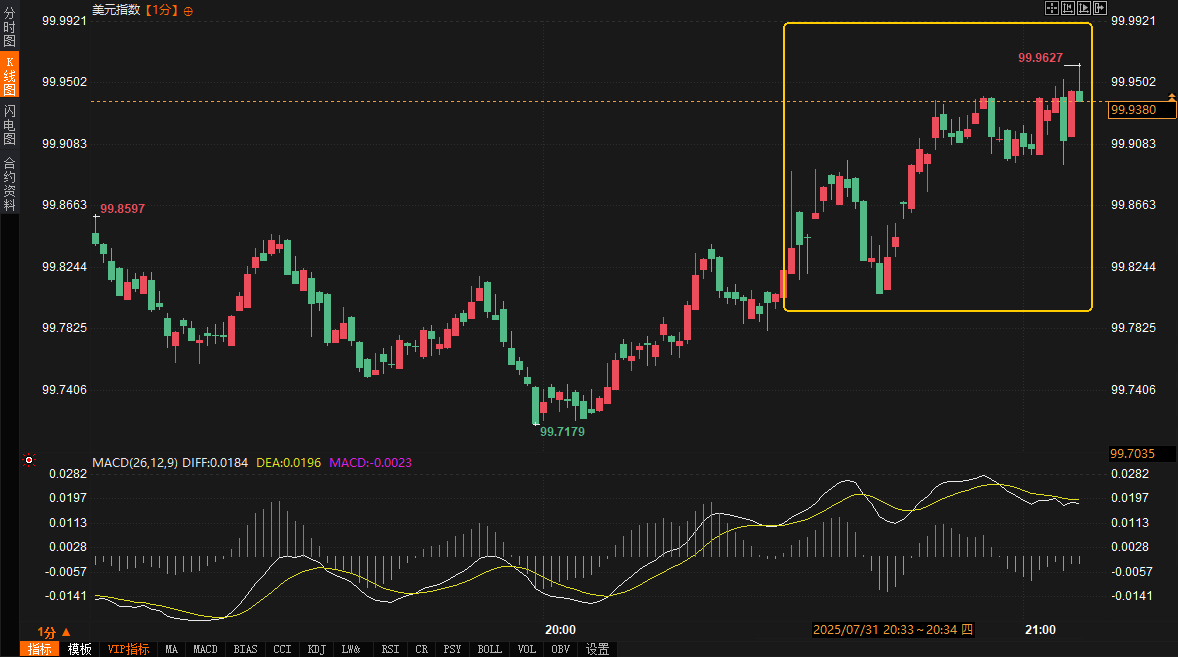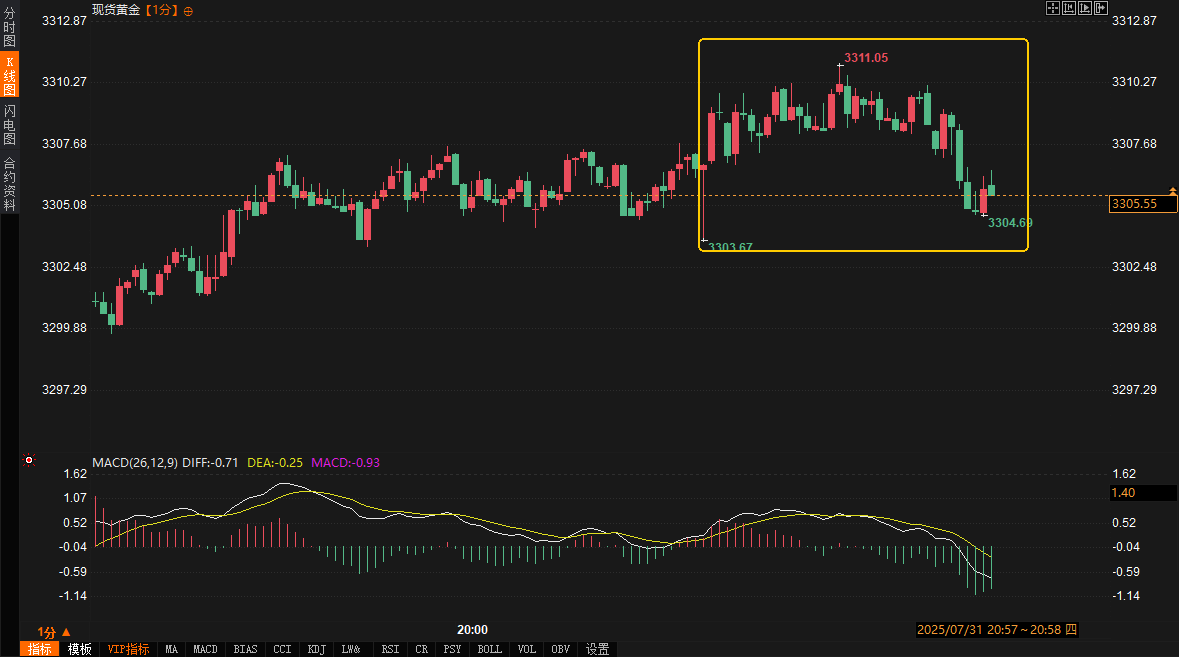PCE attacks the long and short defenses! Trump's attack on Powell deepens the fog on the battlefield, and gold stages a "dark night breakout" at the 3300 mark.
2025-07-31 21:11:51

Following the data release, the US dollar index briefly rose by about 8 points, reaching 99.8916. Spot gold briefly dipped $3 before rebounding to $3,310.16 per ounce. Market sentiment quickly shifted to caution amidst unexpected inflation and the Federal Reserve's hawkish stance. Coupled with Trump's latest criticism of Fed Chairman Powell, investors' expectations for a September rate cut have further cooled. This article will provide an in-depth analysis of the market's immediate reaction, interpretations, and implications for Fed policy and future trends.
Market Background and Data Overview
As July draws to a close, global financial markets are experiencing heightened sensitivity. The Federal Reserve maintained its benchmark interest rate at 4.25%-4.50% on Wednesday (July 30). At a press conference, Powell emphasized that inflation has yet to stabilize at the 2% target, and that the labor market, while balanced, faces downside risks. This statement has reduced market bets on a September rate cut from approximately 65% to 46% (according to CME's FedWatch tool). Meanwhile, Trump's recent criticism of Powell has intensified. Around 7:30 PM on July 31, he again lashed out at Powell on social media, calling him "slow to act and overly politicized" and accusing his policies of costing the US economy "trillions of dollars." This remark heightened market concerns about the Fed's independence and set the stage for risk aversion ahead of the data release.
The June PCE data rebounded unexpectedly, indicating rising inflationary pressures due to tariffs. The resiliency of the core PCE is particularly noteworthy, with a 2.8% year-on-year increase suggesting a challenging downward path for inflation. Personal income rose 0.3%, exceeding expectations by 0.2%, while personal spending rose 0.3%, slightly below the 0.4% forecast, demonstrating consumer resilience amidst high prices. Initial jobless claims data continued its recent low range, with 218,000 suggesting limited willingness for layoffs. However, continuing claims remained high at 1.946 million, indicating increased difficulty finding new jobs for the unemployed and weakening labor market momentum. These data present a mixed message to the market: rising inflationary pressures coexist with a stable labor market, raising uncertainty about the Federal Reserve's policy decisions.
Immediate market reaction and sentiment shift
The market reaction to the data was swift and dramatic. The US dollar index briefly rose by about 8 points, reaching a high of 99.8916, reflecting investor concerns about higher-than-expected inflation and a potential delay in the Federal Reserve's interest rate cuts. Spot gold briefly retreated by about $3 before rebounding, reaching a high of $3,309.85 per ounce and closing at $3,310.16, a 1.08% increase. COMEX gold futures performed relatively mildly, closing at $3,363.20 per ounce, a 0.31% increase. US Treasury yields rose slightly, with both the 10-year and 2-year Treasury yields rising by about 2 basis points, indicating a growing market expectation that the Federal Reserve will maintain high interest rates. In the stock market, the S&P 500 fell slightly by 0.12% in late trading, while the Russell 2000 index fell slightly by 0.47%, reflecting the sensitivity of small and medium-sized enterprises to high interest rates.


The reaction differed significantly from market expectations before the data release. Prior to the release, the consensus forecast for June PCE was 2.5% year-on-year and core PCE 2.7%, with some traders betting that slowing inflation would pave the way for a September rate cut. However, the unexpected rebound in the actual data, particularly the stubborn core PCE reading, directly undermined these optimistic expectations. USD option volatility had already declined before the data release, with clear signs of traders reducing their short USD positions. Short-covering after the data release further drove the dollar higher. GBP/USD continued its six-day losing streak, falling below the middle Bollinger Band of 1.3516, hitting a low of 1.3209 and approaching the key support level of 1.3100, further strengthening its technical bearish trend.
The divergence between institutions and retail investors has intensified
Institutional and retail investors differed in their interpretation of the data. Institutional investors generally focused on the impact of higher-than-expected inflation on Federal Reserve policy. A prominent macro strategist, prior to the data release, noted that if core PCE exceeded expectations, the probability of a September rate cut would decrease significantly. Following the data's release, he added, "The PCE data reinforces the Fed's cautious stance, and the market needs to reassess the timeline for rate cuts." Another firm emphasized Powell's hawkish stance on Wednesday, arguing that it "extinguished hopes for a September rate cut," and noted that the US dollar index had risen to a two-month high, narrowing its year-to-date losses to 8%.
Retail investors were more emotional, with some expressing concern about the inflation data, believing that rising prices due to tariffs will further erode purchasing power. One active trader commented after the data release: "PCE figures were lower than previously reported but higher than expected, suggesting inflation hasn't rebounded due to excessive tariffs. The probability of a September rate cut has increased slightly, but Powell's hawkish remarks tonight will inevitably lead to market volatility." However, some retail investors were optimistic about the labor market data, pointing out that lower-than-expected initial jobless claims demonstrate economic resilience and warn against excessive short-term pessimism. Trump's latest attack on Powell also sparked heated debate, with some users arguing that his remarks exacerbated market uncertainty and boosted demand for safe-haven assets like gold.
The impact of Fed policy and Trump's rhetoric
The Federal Reserve's hawkish stance on Wednesday set the tone for the market. Powell explicitly stated that inflation has yet to stabilize at 2%, and that the labor market's equilibrium, driven in part by a decline in both demand and supply, presents downside risks. This statement, coupled with the unexpected rebound in June's PCE data, reinforced market expectations that the Fed will delay rate cuts. Reputable analysts noted that Powell expressed caution about the price effects of tariffs, believing them to be a "one-off shock" whose transmission could be slower than expected. This means that inflation data will be a key variable in the Fed's decision-making over the coming months.
Trump's continued criticism of Powell has added additional political noise to the market. His latest remarks not only question Powell's leadership but also directly link his policies to economic losses. While the Federal Reserve's independence is protected by law, Trump's public pressure has stoked market concerns about policy uncertainty. Some analysts believe that Trump's tariff rhetoric could further inflate inflation expectations, forcing the Fed to maintain a high interest rate path for a longer period, thereby weighing on the stock market and small and medium-sized enterprises.
Future Trend Outlook
In the short term, the unexpected rebound in June's PCE data and the stabilization of initial jobless claims data point to a complex situation in the US economy, characterized by high inflation and a resilient labor market. The US dollar index stabilized near 99.89, and technical indicators suggest further upside potential. Short-covering could push it above 100. Gold's appeal as a safe-haven asset will persist in the short term, but continued dollar strength may limit its gains. In the stock market, high interest rate expectations and uncertainty surrounding tariff policies will continue to weigh on small and mid-cap stocks, while the S&P 500 is likely to remain range-bound at its current level.
In the medium to long term, the Fed's policy path will be highly dependent on inflation and employment data over the next two months. If core PCE remains elevated, the probability of a September rate cut may further decrease, and the market needs to prepare for a prolonged period of high interest rates. One institutional strategist predicts that the Fed may cut rates three to five times by the end of 2026, but this presupposes a significant decline in inflation. While Trump's tariff rhetoric may boost risk aversion in the short term, its actual impact will depend on policy implementation. Investors should closely monitor the August non-farm payroll report and July PCE data to identify potential policy shifts.
In summary, the June PCE and initial jobless claims data sounded alarm bells for the market. Inflationary pressures, the Fed's hawkish stance, and Trump's political noise have significantly dampened expectations for a September rate cut. The dollar's rebound momentum has strengthened, while gold and stocks are seeking a balance between risk aversion and pressure. The data-driven tussle between data and policy will remain the dominant theme in the coming weeks, and traders should remain vigilant.
- Risk Warning and Disclaimer
- The market involves risk, and trading may not be suitable for all investors. This article is for reference only and does not constitute personal investment advice, nor does it take into account certain users’ specific investment objectives, financial situation, or other needs. Any investment decisions made based on this information are at your own risk.





















